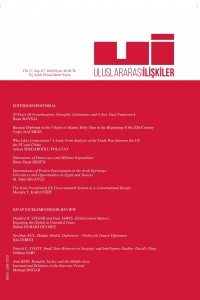Öz
Amit Bein’s well-researched monograph introduces an alternative way of looking at Turkey’s
engagement with the Middle East in the interwar period. Using a wide range of Turkish, Arabic and
English archival materials, plus an abundant number of contemporary newspapers, magazines, travel
accounts and memoirs, the author challenges the widely-accepted view in the secondary literature
that Kemalist Turkey deliberately disengaged with its Middle Eastern neighbours and argues that this
view is “a serious overstatement of the realities” (p. 240). Adopting an approach that goes beyond the
state-to-state understanding of diplomatic history, this book covers not only border issues (Chapter
2), regional relations and security (Chapter 3), but also projects for transportation networks within
the region (Chapter 4) and Turkey’s efforts to create a good image in the Middle East through the use
of propaganda (Chapter 5 and 6).
Öz
Amit Bein’s well-researched monograph introduces an alternative way of looking at Turkey’s
engagement with the Middle East in the interwar period. Using a wide range of Turkish, Arabic and
English archival materials, plus an abundant number of contemporary newspapers, magazines, travel
accounts and memoirs, the author challenges the widely-accepted view in the secondary literature
that Kemalist Turkey deliberately disengaged with its Middle Eastern neighbours and argues that this
view is “a serious overstatement of the realities” (p. 240). Adopting an approach that goes beyond the
state-to-state understanding of diplomatic history, this book covers not only border issues (Chapter
2), regional relations and security (Chapter 3), but also projects for transportation networks within
the region (Chapter 4) and Turkey’s efforts to create a good image in the Middle East through the use
of propaganda (Chapter 5 and 6).
Anahtar Kelimeler
Ayrıntılar
| Birincil Dil | İngilizce |
|---|---|
| Bölüm | Kitap İncelemesi |
| Yazarlar | |
| Yayımlanma Tarihi | 1 Eylül 2020 |
| Yayımlandığı Sayı | Yıl 2020 Cilt: 17 Sayı: 67 |


